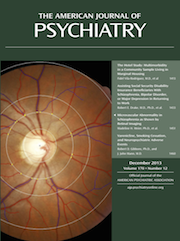ECT for Developmental Disability and Severe Mental Illness
To the Editor: ECT is a treatment of red lines. There was once a red line against its use even in consenting adults, stemming mainly from the antipsychiatry movement of the 1960s and the impact of Hollywood movies (1). Despite enduring stigma, ECT is now available for adults in most states, although significant variations in usage remain (2).
Yet, a second red line remains in effect for minors and individuals with developmental disabilities. In the early days, administering treatments to adolescents and even children was commonplace. But ECT in the pediatric population likewise became stigmatized, and it remains widely rejected despite solid evidence of its efficacy and safety in these patients. In particular, there is a substantial literature on the dramatic benefits of ECT in treating severe affective, psychotic, and catatonic disturbances. A case report describing the alleviation of intractable repetitive self-injurious behavior causing profound bodily damage in an autistic girl with concomitant catatonia was presented in the Journal in 2008 (3).
Restricted access to ECT for all who need it, regardless of age, race, disability, socioeconomic status, or geographical location constitutes an important ethical problem. We are keenly aware that many individuals with affective and behavioral disturbances that respond exquisitely to convulsive therapy, especially children and the intellectually disabled, do not have equal access to it.
The reasons are manifold: insufficient institutional resources and trained specialists, arbitrary prohibitions, and the prevailing view of ECT as a treatment of last resort. Inhibiting regulations dot the American landscape, regulations that affect no other accepted medical intervention. ECT is prohibited for children under age 12 in California and under age 16 in Colorado and Texas; requires court approval for minors in Illinois, Michigan, and Tennessee; and requires independent ethics board approval in New York (4).
It is unclear how many patients are affected by these ill-justified restrictions. No current literature documents the number of U.S. patients with ECT-responsive pathology denied access to treatment, nor patients for whom approval was not sought because of administrative and legal barriers. It may be argued that the situation is comparatively rare. Yet equality of access demands the attention of the larger psychiatric community, not because of the numbers involved but because treatment is so simple. ECT in children, adolescents, and patients with concurrent developmental disability can be life-saving; that it is denied for unscientific reasons is a challenge to the ethical principles of medical care and should be of concern to all practitioners, not just those in the trenches of care for these special populations.
1 : Shock Therapy: A History of Electroconvulsive Treatment in Mental Illness. New Brunswick, NJ, and London, Rutgers University Press, 2007Google Scholar
2 : Electroshock: Restoring the Mind. New York, Oxford University Press, 1999Google Scholar
3 : ECT for catatonia in an autistic girl. Am J Psychiatry 2008; 165:329–333Link, Google Scholar
4 : Medical, judicial, and statutory regulation of ECT in the United States. Am J Psychiatry 1984; 141:1349–1355Link, Google Scholar



